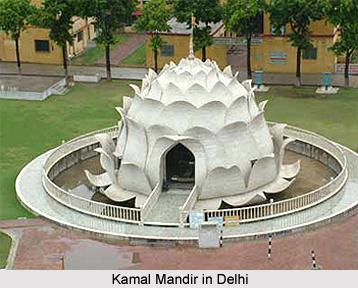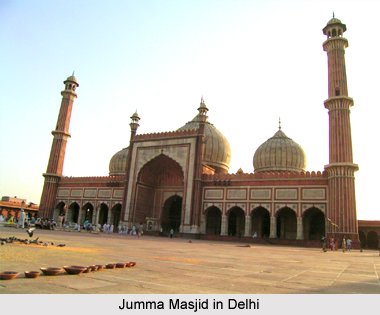 History of Delhi goes back to centuries back and narrates some of the most significant occurrences in the history of India. The earliest architectural relics of Delhi date back to the Maurya Empire (c. 300 BC). The history of Delhi murmurs the tale of ancient and buried timelines.
History of Delhi goes back to centuries back and narrates some of the most significant occurrences in the history of India. The earliest architectural relics of Delhi date back to the Maurya Empire (c. 300 BC). The history of Delhi murmurs the tale of ancient and buried timelines.
According to Jawaharlal Nehru, "Delhi is the symbol of old India and new...even the stones here whisper to our ears of the ages of long ago and the air we breathe is full of the dust and fragrances of the past, as also of the fresh and piercing words of the present".
Early History of Delhi
The early history of Delhi began with the rule of Indian kings in Indraprastha, which is depicted in Mahabharata. Yamuna River flowing by the city bears witness to the glorious and tumultuous 5,000-year-old history of Delhi. The history of Delhi begins with the creation of Indraprastha by the Pandavas and the transformation of this barren gift of the Kauravas into a tranquil heaven. From the time of the Mauryan Empire, there have been settlements here. The ruins of seven major cities have been discovered in Delhi.
It was in AD 736, that the Tomara Rajput dynasty founded the city of Lal Kot or Qila Rai Pithora. In 1180, the Chauhans, the rivals of the Rajput clan ousted the Tomaras and renamed the city as Quila Rai Pithora. Only for a decade the Chauhans remained here. In 1191 AD, with the decline of Hindu rule, the Delhi Sultanate came into power and thus began the medieval era.
Medieval History of Delhi
 The medieval history of Delhi was recorded with the Second Battle of Tarain in 1192 AD where Mohammad Ghori attacked and plundered north India. The two consecutive battles of Tarain 1191 and 1192, the Rajputs first managed to restrain an invading force from Afghanistan, led by Muhammad Ghuri but surrendered a few months later. After Ghuri`s assassination in 1206, his provinces, forts and monuments were kept unharmed in the hands of his Turkish general, Qutub-ud-din-Aibak, the creator of the Slave dynasty or Mamulak dynasty also known as Delhi Sultanate and became the first Muslim ruler of Delhi. He also constructed the Qutub Minar. His successor, Iltutmish, was possibly the greatest of the early Delhi Sultans.
The medieval history of Delhi was recorded with the Second Battle of Tarain in 1192 AD where Mohammad Ghori attacked and plundered north India. The two consecutive battles of Tarain 1191 and 1192, the Rajputs first managed to restrain an invading force from Afghanistan, led by Muhammad Ghuri but surrendered a few months later. After Ghuri`s assassination in 1206, his provinces, forts and monuments were kept unharmed in the hands of his Turkish general, Qutub-ud-din-Aibak, the creator of the Slave dynasty or Mamulak dynasty also known as Delhi Sultanate and became the first Muslim ruler of Delhi. He also constructed the Qutub Minar. His successor, Iltutmish, was possibly the greatest of the early Delhi Sultans.
In the history of Delhi, the Slave Dynasty (1211-1227) was followed by the Khalji dynasty (1296-1316) and during the rule of Ala-ud-din Khalji, the second city of Delhi was built which is known as Siri. Today, Siri is situated where the Siri Fort and the modern day Asiad Village Complex are positioned.
The third city of Delhi - Tughluqabad was founded by the Tughluq dynasty soon after in 1320 AD. However, very little remains of this can be seen in present day Delhi. The fourth city of Delhi - Jahanpanahn was built in 1327 AD between Lal Kot and Siri. The next Sultan Firoz Shah Tuglaq built the fifth city of Delhi in 1354 AD - Firozabad District. The Tughlaq`s were succeeded by the Central Asian Turk, Timur, who was later succeeded by the Sayyid dynasty. The Lodi dynasty followed very soon and the only interesting architectural features added by them were the tombs, the finest of which may be seen at the Lodi Gardens.
The well-known battle of Panipat fought in 1526 marked the beginning of Mughal dynasty in India, a period in Indian history that was very significant. Babur and Humayun were the early Mughal rulers that were interrupted by a 15-year break in Mughal rule when Sher Shah Suri an Afghan king ruled over Delhi. He built the fort Din-Panah - the 6th city on the banks of the Yamuna, which is presently known as the “Purana Qilainâ€.
 When Emperor Akbar took over, the capital was shifted to Agra. However in 1628 AD, Delhi was again made the capital of the Mughal Empire under the reign of Emperor Shah Jahan. In Shah Jahan`s rule, Delhi experienced the construction of some of the finest pieces of Mughal architecture. There was the new walled capital of Shahjahanbad - the 7th city of Delhi, which is now known as Old Delhi with the heritage sites of Red Fort and the Jama Masjid. During the rule of Aurangzeb, the capital Delhi was shifted to Aurangabad, which is located in Maharashtra. After his death in 1707, Mughal Empire was shattered into pieces and many regional powers rose into prominence and later British East India Company intervened in the political situation and began to rule India in the midst of bloodshed revolts and oppressions.
When Emperor Akbar took over, the capital was shifted to Agra. However in 1628 AD, Delhi was again made the capital of the Mughal Empire under the reign of Emperor Shah Jahan. In Shah Jahan`s rule, Delhi experienced the construction of some of the finest pieces of Mughal architecture. There was the new walled capital of Shahjahanbad - the 7th city of Delhi, which is now known as Old Delhi with the heritage sites of Red Fort and the Jama Masjid. During the rule of Aurangzeb, the capital Delhi was shifted to Aurangabad, which is located in Maharashtra. After his death in 1707, Mughal Empire was shattered into pieces and many regional powers rose into prominence and later British East India Company intervened in the political situation and began to rule India in the midst of bloodshed revolts and oppressions.
Modern History of Delhi
Delhi witnessed chaotic times, different rulers and dynasties and finally in 1803 AD, the British Government in India who had already time-honoured their presence in India, took over power in Delhi. Delhi became the focal point for the First War of Independence in 1857. Though the revolt did not reach its objected end, Delhi became a thorn in the eyes of the British.
As the British Government in India shifted their capital from Kolkata to Delhi, all the actions during the freedom struggle were carried on in Delhi. Thus, Delhi bears several marks of the freedom struggle. It was the hosting of the tri-colour Indian national flag at Red Fort in Delhi that marked a significant chapter in the history of India.
After Independence on 15 August 1947, Delhi was officially declared as the seat of the Government of India and the capital of the Republic of India. With Independence, it was in Delhi that the British Government transferred the power to India`s first democratically elected Government under the Prime Minister Pandit Jawaharlal Nehru. In the wake of the Partition of India, Hindu mobs turned on Delhi`s Muslim population and nearly half of them fled to Pakistan ending centuries of Muslim dominance in the city and they were replaced by an arrival of Hindu and Sikh refugees from the Pakistani sectors of Punjab and Bengal.
In 1950, Delhi was made the capital city of Independent India and in 1992 it was declared as a Union Territory and NCR. The history of Delhi is believed to be one of the most glorious and stately one in the history of India.






